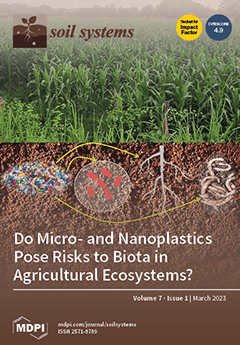The agricultural soils of West Limerick, Ireland, contain very localised, extremely high natural Se concentrations that reach levels that are very toxic to grazing livestock. The Carboniferous shales that formed in anoxic deep-water marine environments are the source of the selenium, which, along
[...] Read more.
The agricultural soils of West Limerick, Ireland, contain very localised, extremely high natural Se concentrations that reach levels that are very toxic to grazing livestock. The Carboniferous shales that formed in anoxic deep-water marine environments are the source of the selenium, which, along with the other redox-sensitive elements of molybdenum, uranium, arsenic and vanadium, were mobilised and reprecipitated in post-glacial anoxic marshes. The result has been a history of selenosis and molybdenosis in livestock in this important dairy province. Soils collected at 10–20 cm from five different agricultural sites were analysed, and all yielded concentrations greatly in excess of the safe Se limits of 3–10 mg kg
−1; the highest value recorded was 1265.8 mg kg
−1 Se. The highest recorded value for Mo in these soils was 1627.5 mg kg
−1, and for U, 658.8 mg kg
−1. There was a positive correlation between Se, Mo U and organic matter in the soils. Analysis of non-accumulator pasture grasses (
Lolium perenne (perennial ryegrass),
Festuca arundinacea (tall fescue),
Dactylis glomerata (cocksfoot) and
Phleum pretense (timothy grass)) revealed the shoot/leaf to contain up to 78.05 mg kg
−1 Se while
Trifolium repens (white clover) leaves contained 296.15 mg kg
−1 Se. An in situ growing experiment using the Se accumulator species
Brassica oleracea revealed 971.2 mg kg
−1 Se in the leaves of premier kale, which also contained 1000.4 mg kg
−1 Mo. Translocation factors (TFs) were generally higher for Mo than Se across all plant species. Combined X-ray absorption near edge spectroscopy (XANES) with micro-X-ray fluorescence (
μ-XRF) showed the Se was present in the soil predominantly as the reduced immobile phase, elemental Se (Se
0), but also as bioavailable organoselenium species, mainly selenomethionine (SeMet). SeMet was also the main species identified within both the Se non-accumulator and Se accumulator plants. The Se soil–plant system in West Limerick is dominated by SeMet, and uptake into the cattle pasture results in selenosis in the grazing dairy herds. The hyperaccumulating
Brassica oleracea species could be used to extract both the Se and Mo to reduce the toxicity of the blighted fields.
Full article





